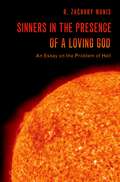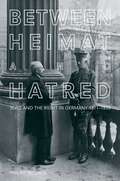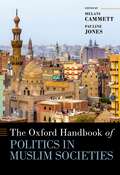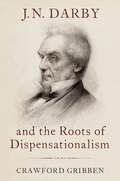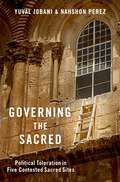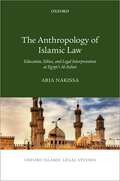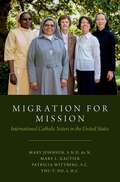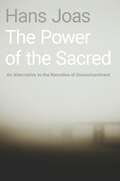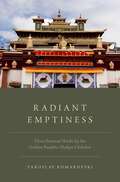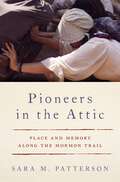- Table View
- List View
Sinners in the Presence of a Loving God: An Essay on the Problem of Hell
by R. Zachary ManisWhy would a perfectly good and loving God consign anyone to eternal suffering in hell? In Sinners in the Presence of a Loving God, R. Zachary Manis examines in detail the various facets of the problem of hell, considers the reasons why the usual responses to the problem are unsatisfying, and suggests how an adequate solution to the problem can be constructed. Historically, there are four standard explanations of the nature and purpose of hell: traditionalism, annihilationism, the choice model, and universalism. In Manis's assessment, all are deficient in some crucial respect. The alternative view that he develops and defends, the divine presence model, stands within the tradition that understands hell to be a state of eternal conscious suffering, but, Manis contends, avoids the worst problems of its competitors. The key idea is that the suffering of hell is not the result of a divine act that aims to inflict it, but rather is the way in which a sinful creature necessarily experiences the unmitigated presence of a holy God. Heaven and hell are not two "places" to which the saved and damned are consigned, respectively, but rather are two radically different ways in which different persons will experience the same reality of God's omnipresence once the barrier of divine hiddenness is finally removed.
Sinners in the Presence of a Loving God: An Essay on the Problem of Hell
by R. Zachary ManisWhy would a perfectly good and loving God consign anyone to eternal suffering in hell? In Sinners in the Presence of a Loving God, R. Zachary Manis examines in detail the various facets of the problem of hell, considers the reasons why the usual responses to the problem are unsatisfying, and suggests how an adequate solution to the problem can be constructed. Historically, there are four standard explanations of the nature and purpose of hell: traditionalism, annihilationism, the choice model, and universalism. In Manis's assessment, all are deficient in some crucial respect. The alternative view that he develops and defends, the divine presence model, stands within the tradition that understands hell to be a state of eternal conscious suffering, but, Manis contends, avoids the worst problems of its competitors. The key idea is that the suffering of hell is not the result of a divine act that aims to inflict it, but rather is the way in which a sinful creature necessarily experiences the unmitigated presence of a holy God. Heaven and hell are not two "places" to which the saved and damned are consigned, respectively, but rather are two radically different ways in which different persons will experience the same reality of God's omnipresence once the barrier of divine hiddenness is finally removed.
Saving the Nation: Chinese Protestant Elites and the Quest to Build a New China, 1922-1952
by Thomas H. ReillyWhile Protestant Christians made up only a small percentage of China's overall population during the Republican period, they were heavily represented among the urban elite. Protestant influence was exercised through churches, hospitals, and schools, and reached beyond these institutions into organizations such as the YMCA (Young Men's Christian Association) and YWCA (Young Women's Christian Association). The YMCA's city associations drew their membership from the urban elite and were especially influential within the modern sectors of urban society. Chinese Protestant leaders adapted the social message and practice of Christianity to the conditions of the republican era. Key to this effort was their belief that Christianity could save China that is, that Christianity could be more than a religion focused on saving individuals, but could also save a people, a society, and a nation. Saving the Nation recounts the history of the Protestant elite beginning with their participation in social reform campaigns in the early twentieth century, continuing through their contribution to the resistance against Japanese imperialism, and ending with Protestant support for a social revolution. The story Thomas Reilly tells is one about the Chinese Protestant elite and the faith they adopted and adapted, Social Christianity. But it is also a broader story about the Chinese people and their struggle to strengthen and renew their nation to build a New China.
Saving the Nation: Chinese Protestant Elites and the Quest to Build a New China, 1922-1952
by Thomas H. ReillyWhile Protestant Christians made up only a small percentage of China's overall population during the Republican period, they were heavily represented among the urban elite. Protestant influence was exercised through churches, hospitals, and schools, and reached beyond these institutions into organizations such as the YMCA (Young Men's Christian Association) and YWCA (Young Women's Christian Association). The YMCA's city associations drew their membership from the urban elite and were especially influential within the modern sectors of urban society. Chinese Protestant leaders adapted the social message and practice of Christianity to the conditions of the republican era. Key to this effort was their belief that Christianity could save China that is, that Christianity could be more than a religion focused on saving individuals, but could also save a people, a society, and a nation. Saving the Nation recounts the history of the Protestant elite beginning with their participation in social reform campaigns in the early twentieth century, continuing through their contribution to the resistance against Japanese imperialism, and ending with Protestant support for a social revolution. The story Thomas Reilly tells is one about the Chinese Protestant elite and the faith they adopted and adapted, Social Christianity. But it is also a broader story about the Chinese people and their struggle to strengthen and renew their nation to build a New China.
Between Heimat and Hatred: Jews and the Right in Germany, 1871-1935
by Philipp NielsenIn the decades between German unification and the demise of the Weimar Republic, German Jewry negotiated their collective and individual identity under the impression of legal emancipation, continued antisemitism, the emergence of Zionism and Socialism, the First World War, and revolution and the republic. For many German Jews liberalism and also increasingly Socialism became attractive propositions. Yet conservative parties and political positions right-of-center also held appeal for some German Jews. Between Heimat and Hatred studies German Jews involved in ventures that were from the beginning, or became increasingly, of the Right. Jewish agricultural settlement, Jews' participation in the so-called "Defense of Germandom in the East", their place in military and veteran circles and finally right-of-center politics form the core of this book. These topics created a web of social activities and political persuasions neither entirely conservative nor entirely liberal. For those German Jews engaging with these issues, their motivation came from sincere love of their German Heimat-a term for home imbued with a deep sense of belonging-and from their middle-class environment, as well as to repudiate antisemitic stereotypes of rootlessness, intellectualism or cosmopolitanism. This tension stands at the heart of the book. The book also asks when did the need for self-defense start to outweigh motivations of patriotism and class? Until when could German Jews espouse views to the right of the political spectrum without appearing extreme to either Jews or non-Jews? In an exploration of identity and exclusion, Philipp Nielsen locates the moments when active Jewish members of conservative projects became the radical other. He notes that the decisive stage of the transformation of the German Right occurred precisely during a period of republican stabilization, when even mainstream right-of-center politics abandoned the state-centric, Volk-based ethnic concepts of the Weimar republic. The book builds on recent studies of Jews' relation to German nationalism, the experience of German Jews away from the large cities, and the increasing interest in Germans' obsession with regional roots and the East. The study follows these lines of inquiry to investigate the participation of some German Jews in projects dedicated to originally, or increasingly, illiberal projects. As such it shines light on an area in which Jewish participation has thus far only been treated as an afterthought and illuminates both Jewish and German history afresh.
Between Heimat and Hatred: Jews and the Right in Germany, 1871-1935
by Philipp NielsenIn the decades between German unification and the demise of the Weimar Republic, German Jewry negotiated their collective and individual identity under the impression of legal emancipation, continued antisemitism, the emergence of Zionism and Socialism, the First World War, and revolution and the republic. For many German Jews liberalism and also increasingly Socialism became attractive propositions. Yet conservative parties and political positions right-of-center also held appeal for some German Jews. Between Heimat and Hatred studies German Jews involved in ventures that were from the beginning, or became increasingly, of the Right. Jewish agricultural settlement, Jews' participation in the so-called "Defense of Germandom in the East", their place in military and veteran circles and finally right-of-center politics form the core of this book. These topics created a web of social activities and political persuasions neither entirely conservative nor entirely liberal. For those German Jews engaging with these issues, their motivation came from sincere love of their German Heimat-a term for home imbued with a deep sense of belonging-and from their middle-class environment, as well as to repudiate antisemitic stereotypes of rootlessness, intellectualism or cosmopolitanism. This tension stands at the heart of the book. The book also asks when did the need for self-defense start to outweigh motivations of patriotism and class? Until when could German Jews espouse views to the right of the political spectrum without appearing extreme to either Jews or non-Jews? In an exploration of identity and exclusion, Philipp Nielsen locates the moments when active Jewish members of conservative projects became the radical other. He notes that the decisive stage of the transformation of the German Right occurred precisely during a period of republican stabilization, when even mainstream right-of-center politics abandoned the state-centric, Volk-based ethnic concepts of the Weimar republic. The book builds on recent studies of Jews' relation to German nationalism, the experience of German Jews away from the large cities, and the increasing interest in Germans' obsession with regional roots and the East. The study follows these lines of inquiry to investigate the participation of some German Jews in projects dedicated to originally, or increasingly, illiberal projects. As such it shines light on an area in which Jewish participation has thus far only been treated as an afterthought and illuminates both Jewish and German history afresh.
Building the Buddhist Revival: Reconstructing Monasteries in Modern China
by Gregory Adam ScottBetween 1850 and 1966, tens of thousands of Buddhist sacred sites in China were destroyed, victims of targeted destruction, accidental damage, or simply neglect. During the same period, however, many of these sites were reconstructed, a process that involved both rebuilding material structures and reviving religious communities. The conventionally accepted narrative of Chinese Buddhism during the modern era is that it underwent a revival initiated by innovative monastics and laypersons, leaders who reinvented Buddhist traditions to meet the challenges of modernity. Gregory Adam Scott shows, however, that over time it became increasingly difficult for reconstruction leaders to resist the interests of state actors, who sought to refashion monastery sites as cultural monuments rather than as living religious communities. These sites were then intended to serve as symbols of Chinese history and cultural heritage, while their function as a frame for religious life was increasingly pushed aside. As a result, the power to determine whether and how a monastery would be reconstructed, and the types of activities that would be reinstated or newly introduced, began to shift from religious leaders and communities to state agencies that had a radically different set of motivations and values. Building the Buddhist Revival explores the history of Chinese Buddhist monastery reconstruction from the end of the Imperial period through the first seventeen years of the People's Republic. Over this century of history, the nature and significance of reconstructing Buddhist monasteries changes drastically, mirroring broader changes in Chinese society. Yet this book argues that change has always been in the nature of religious communities such as Buddhist monasteries, and that reconstruction, rather than a return to the past, represents innovative and adaptive change. In this way, it helps us understand the broader significance of the Buddhist "revival" in China during this era, as a creative reconstruction of religion upon longstanding foundations.
Building the Buddhist Revival: Reconstructing Monasteries in Modern China
by Gregory Adam ScottBetween 1850 and 1966, tens of thousands of Buddhist sacred sites in China were destroyed, victims of targeted destruction, accidental damage, or simply neglect. During the same period, however, many of these sites were reconstructed, a process that involved both rebuilding material structures and reviving religious communities. The conventionally accepted narrative of Chinese Buddhism during the modern era is that it underwent a revival initiated by innovative monastics and laypersons, leaders who reinvented Buddhist traditions to meet the challenges of modernity. Gregory Adam Scott shows, however, that over time it became increasingly difficult for reconstruction leaders to resist the interests of state actors, who sought to refashion monastery sites as cultural monuments rather than as living religious communities. These sites were then intended to serve as symbols of Chinese history and cultural heritage, while their function as a frame for religious life was increasingly pushed aside. As a result, the power to determine whether and how a monastery would be reconstructed, and the types of activities that would be reinstated or newly introduced, began to shift from religious leaders and communities to state agencies that had a radically different set of motivations and values. Building the Buddhist Revival explores the history of Chinese Buddhist monastery reconstruction from the end of the Imperial period through the first seventeen years of the People's Republic. Over this century of history, the nature and significance of reconstructing Buddhist monasteries changes drastically, mirroring broader changes in Chinese society. Yet this book argues that change has always been in the nature of religious communities such as Buddhist monasteries, and that reconstruction, rather than a return to the past, represents innovative and adaptive change. In this way, it helps us understand the broader significance of the Buddhist "revival" in China during this era, as a creative reconstruction of religion upon longstanding foundations.
The Oxford Handbook of Politics in Muslim Societies (Oxford Handbooks)
Muslim societies are largely absent from the study of religion and politics in the social sciences, despite the fact that scholarly literature often presumes that religion exercises a colossal influence on social, political, and economic outcomes in predominantly Muslim countries. This volume utilizes real world events and newly available data to more fully integrate the study of politics in Muslim societies into mainstream comparative analytical frameworks. Moreover, it explores the extent to which theories about core topics of inquiry in political science apply to Muslim societies. The aim is to interrogate rather than presume both whether and how Islam and Muslims are distinct from other religions and religious communities. Through 40 chapters by leading specialists, the Oxford Handbook of Politics in Muslim Societies examines a wide range of topics concerning regimes and regime change, electoral politics, political attitudes and behavior beyond voting, social mobilization, economic performance and development outcomes, and social welfare and governance. The Handbook shifts focus away from the Arab world as the barometer of politics in the Muslim world, recognizing that the Islamic world spans several regions including Africa, Southeast Asia, South Asia, and Central Asia. This expanded geography enables a thorough investigation of which relationships, if any, hold across Muslim majority states in different regions of the world.
The Oxford Handbook of Politics in Muslim Societies (Oxford Handbooks)
by Melani Cammett and Pauline JonesMuslim societies are largely absent from the study of religion and politics in the social sciences, despite the fact that scholarly literature often presumes that religion exercises a colossal influence on social, political, and economic outcomes in predominantly Muslim countries. This volume utilizes real world events and newly available data to more fully integrate the study of politics in Muslim societies into mainstream comparative analytical frameworks. Moreover, it explores the extent to which theories about core topics of inquiry in political science apply to Muslim societies. The aim is to interrogate rather than presume both whether and how Islam and Muslims are distinct from other religions and religious communities. Through 40 chapters by leading specialists, the Oxford Handbook of Politics in Muslim Societies examines a wide range of topics concerning regimes and regime change, electoral politics, political attitudes and behavior beyond voting, social mobilization, economic performance and development outcomes, and social welfare and governance. The Handbook shifts focus away from the Arab world as the barometer of politics in the Muslim world, recognizing that the Islamic world spans several regions including Africa, Southeast Asia, South Asia, and Central Asia. This expanded geography enables a thorough investigation of which relationships, if any, hold across Muslim majority states in different regions of the world.
The Twentysomething Soul: Understanding the Religious and Secular Lives of American Young Adults
by Tim Clydesdale Kathleen Garces-FoleyToday's twentysomethings have been labeled the "lost generation" for their presumed inability to identify and lead fulfilling lives, "kidults" for their alleged refusal to "grow up" and accept adult responsibilities, and the "least religious generation" for their purported disinterest in religion and spirituality. These characterizations are not only unflattering -- they are wrong. The Twentysomething Soul tells an optimistic story about American twentysomethings by introducing readers to the full spectrum of American young adults, many of whom live purposefully, responsibly, and reflectively. Some prioritize faith and involvement in a religious congregation. Others reject their childhood religion to explore alternatives and practice a personal spirituality. Still others sideline religion and spirituality until their lives get settled, or reject organized religion completely. Drawing from interviews with more than 200 young adults, as well as national survey of 1,880 twentysomethings, Tim Clydesdale and Kathleen Garces-Foley seek to change the way we view contemporary young adults, giving an accurate and refreshing understanding of their religious, spiritual, and secular lives.
The Twentysomething Soul: Understanding the Religious and Secular Lives of American Young Adults
by Tim Clydesdale Kathleen Garces-FoleyToday's twentysomethings have been labeled the "lost generation" for their presumed inability to identify and lead fulfilling lives, "kidults" for their alleged refusal to "grow up" and accept adult responsibilities, and the "least religious generation" for their purported disinterest in religion and spirituality. These characterizations are not only unflattering -- they are wrong. The Twentysomething Soul tells an optimistic story about American twentysomethings by introducing readers to the full spectrum of American young adults, many of whom live purposefully, responsibly, and reflectively. Some prioritize faith and involvement in a religious congregation. Others reject their childhood religion to explore alternatives and practice a personal spirituality. Still others sideline religion and spirituality until their lives get settled, or reject organized religion completely. Drawing from interviews with more than 200 young adults, as well as national survey of 1,880 twentysomethings, Tim Clydesdale and Kathleen Garces-Foley seek to change the way we view contemporary young adults, giving an accurate and refreshing understanding of their religious, spiritual, and secular lives.
J.N. Darby and the Roots of Dispensationalism
by Crawford GribbenJ.N. Darby and the Roots of Dispensationalism describes the work of one of the most important and under-studied theologians in the history of Christianity. In the late 1820s, John Nelson Darby abandoned his career as a priest in the Church of Ireland to become one of the principal leaders of a small but rapidly growing religious movement that became known as the ?Plymouth Brethren.? Darby and other brethren modified the Calvinism that was common among their evangelical contemporaries, developing distinctive positions on key doctrines relating to salvation, the church, the work of the Holy Spirit, and the end times. After his death in 1882, Darby's successors revised and expanded his arguments, and Darby became known as the architect of the most influential system of end-times thinking among the world's half-a-billion evangelicals. This ?dispensational premillennialism? exercises extraordinary influence in religious communities, but also in popular culture and geopolitics. But claims that Darby created this theological system may need to be qualified -for all his innovation, this reputation might be undeserved. This book reconstructs Darby's theological development and argues that his innovations were more complex and extensive than their reduction into dispensationalism might suggest. In fact, Darby's thought might be closer to that of his Reformed critics than to that of modern exponents of dispensationalism.
J.N. Darby and the Roots of Dispensationalism
by Crawford GribbenJ.N. Darby and the Roots of Dispensationalism describes the work of one of the most important and under-studied theologians in the history of Christianity. In the late 1820s, John Nelson Darby abandoned his career as a priest in the Church of Ireland to become one of the principal leaders of a small but rapidly growing religious movement that became known as the ?Plymouth Brethren.? Darby and other brethren modified the Calvinism that was common among their evangelical contemporaries, developing distinctive positions on key doctrines relating to salvation, the church, the work of the Holy Spirit, and the end times. After his death in 1882, Darby's successors revised and expanded his arguments, and Darby became known as the architect of the most influential system of end-times thinking among the world's half-a-billion evangelicals. This ?dispensational premillennialism? exercises extraordinary influence in religious communities, but also in popular culture and geopolitics. But claims that Darby created this theological system may need to be qualified -for all his innovation, this reputation might be undeserved. This book reconstructs Darby's theological development and argues that his innovations were more complex and extensive than their reduction into dispensationalism might suggest. In fact, Darby's thought might be closer to that of his Reformed critics than to that of modern exponents of dispensationalism.
Governing the Sacred: Political Toleration in Five Contested Sacred Sites
by Yuval Jobani Nahshon PerezHoly sites are often at the center of intense contestation between different groups regarding a wide variety of issues, including ownership, access, usage rights, permissible religious conduct, and many others. They are often the source of intractable long-standing conflicts and extreme violence. These difficulties are exemplified by the five sites profiled in Governing the Sacred: Devils Tower National Monument (Wyoming, US), Babri Masjid/Ram Janmabhoomi (Uttar-Pradesh, India), the Western Wall (Jerusalem), the Church of the Holy Sepulchre (Jerusalem), and the Temple Mount/Haram esh-Sharif (Jerusalem). Telling the fascinating stories of these high-profile contested sites, the authors develop and critically explore five different models of governing such sites: "non-interference," "separation and division," "preference," "status-quo," and "closure." Each model relies on different sets of considerations; central among them are trade-offs between religious liberty and social order. This novel typology aims to assist democratic governments in their attempt to secure public order and mutual toleration among opposed groups in contested sacred sites.
Governing the Sacred: Political Toleration in Five Contested Sacred Sites
by Nahshon Perez Yuval JobaniHoly sites are often at the center of intense contestation between different groups regarding a wide variety of issues, including ownership, access, usage rights, permissible religious conduct, and many others. They are often the source of intractable long-standing conflicts and extreme violence. These difficulties are exemplified by the five sites profiled in Governing the Sacred: Devils Tower National Monument (Wyoming, US), Babri Masjid/Ram Janmabhoomi (Uttar-Pradesh, India), the Western Wall (Jerusalem), the Church of the Holy Sepulchre (Jerusalem), and the Temple Mount/Haram esh-Sharif (Jerusalem). Telling the fascinating stories of these high-profile contested sites, the authors develop and critically explore five different models of governing such sites: "non-interference," "separation and division," "preference," "status-quo," and "closure." Each model relies on different sets of considerations; central among them are trade-offs between religious liberty and social order. This novel typology aims to assist democratic governments in their attempt to secure public order and mutual toleration among opposed groups in contested sacred sites.
The Anthropology of Islamic Law: Education, Ethics, and Legal Interpretation at Egypt's Al-Azhar (Oxford Islamic Legal Studies)
by Aria NakissaThe Anthropology of Islamic Law shows how hermeneutic theory and practice theory can be brought together to analyze cultural, legal, and religious traditions. These ideas are developed through an analysis of the Islamic legal tradition, which examines both Islamic legal doctrine and religious education. The book combines anthropology and Islamicist history, using ethnography and in-depth analysis of Arabic religious texts. The book focuses on higher religious learning in contemporary Egypt, examining its intellectual, ethical, and pedagogical dimensions. Data is drawn from fieldwork inside al-Azhar University, Cairo University's Dar al-Ulum, and the network of traditional study circles associated with the al-Azhar mosque. Together these sites constitute the most important venue for the transmission of religious learning in the contemporary Muslim world. The book gives special attention to contemporary Egypt, and also provides a broader analysis relevant to Islamic legal doctrine and religious education throughout history.
The Anthropology of Islamic Law: Education, Ethics, and Legal Interpretation at Egypt's Al-Azhar (Oxford Islamic Legal Studies)
by Aria NakissaThe Anthropology of Islamic Law shows how hermeneutic theory and practice theory can be brought together to analyze cultural, legal, and religious traditions. These ideas are developed through an analysis of the Islamic legal tradition, which examines both Islamic legal doctrine and religious education. The book combines anthropology and Islamicist history, using ethnography and in-depth analysis of Arabic religious texts. The book focuses on higher religious learning in contemporary Egypt, examining its intellectual, ethical, and pedagogical dimensions. Data is drawn from fieldwork inside al-Azhar University, Cairo University's Dar al-Ulum, and the network of traditional study circles associated with the al-Azhar mosque. Together these sites constitute the most important venue for the transmission of religious learning in the contemporary Muslim world. The book gives special attention to contemporary Egypt, and also provides a broader analysis relevant to Islamic legal doctrine and religious education throughout history.
Migration for Mission: International Catholic Sisters in the United States
by Mary Johnson Mary Gautier Patricia Wittberg Thu T. DoPatterns of migration for the purpose of religious mission are an unexamined dimension of the immigration narrative. Catholic sisters from many countries around the world come to the United States to minister and to study. Sociologists from Trinity Washington University and CARA at Georgetown University combined forces to document and understand this contemporary and historical phenomenon. Together, they located more than 4,000 "international sisters" who are currently in the United States for formation, studies, or ministry, from 83 countries spread over six continents. Through surveys, focus groups, and interviews, they heard the stories of these sisters and learned of their joys and satisfactions as well as their struggles and challenges. This book examines the experience of these sisters in depth and offers valuable suggestions for religious institutes, Catholic dioceses and parishes, and others who benefit from their contributions. More broadly, this book also raises awareness of immigration issues at a time of great contention in the public policy debate in the United States. Illustrated with instructive graphics and tables, it is an accessible and inviting resource for academics and the media, as well as bishops, and leaders of Catholic health care, social service, education, pastoral, and philanthropic institutions.
Migration for Mission: International Catholic Sisters in the United States
by Mary Johnson Mary Gautier Patricia Wittberg Thu T. DoPatterns of migration for the purpose of religious mission are an unexamined dimension of the immigration narrative. Catholic sisters from many countries around the world come to the United States to minister and to study. Sociologists from Trinity Washington University and CARA at Georgetown University combined forces to document and understand this contemporary and historical phenomenon. Together, they located more than 4,000 "international sisters" who are currently in the United States for formation, studies, or ministry, from 83 countries spread over six continents. Through surveys, focus groups, and interviews, they heard the stories of these sisters and learned of their joys and satisfactions as well as their struggles and challenges. This book examines the experience of these sisters in depth and offers valuable suggestions for religious institutes, Catholic dioceses and parishes, and others who benefit from their contributions. More broadly, this book also raises awareness of immigration issues at a time of great contention in the public policy debate in the United States. Illustrated with instructive graphics and tables, it is an accessible and inviting resource for academics and the media, as well as bishops, and leaders of Catholic health care, social service, education, pastoral, and philanthropic institutions.
The Power of the Sacred: An Alternative to the Narrative of Disenchantment
by Hans JoasDisenchantment is a key term in the self-understanding of modernity. But what exactly does this concept mean? What was its original meaning when Max Weber introduced it? And can the conventional meaning or Max Weber's view really be defended, given the present state of knowledge about the history of religion? In The Power of the Sacred, Hans Joas develops the fundamentals of a new sociological theory of religion by first reconstructing existing theories, from the eighteenth century to the present. Through a critical reading and reassessment of key texts in the three empirical disciplines of history, psychology, and sociology of religion, including the works of David Hume, J.G. Herder, Friedrich Schleiermacher, William James, Emile Durkheim, and Ernst Troeltsch, Joas presents an understanding of religion that lays the groundwork for a thorough study of Max Weber's views on disenchantment. After deconstructing Weber's highly ambiguous use of the concept, Joas proposes an alternative to the narratives of disenchantment and secularization which have dominated debates on the topic. He constructs a novel interpretation that takes into account the dynamics of ever new sacralizations, their normative evaluation in the light of a universalist morality as it first emerged in the "Axial Age," and the dangers of the misuse of religion in connection with the formation of power. Built upon the human experience of self-transcendence, rather than human cognition or cultural discourses, The Power of the Sacred challenges both believers and non-believers alike to rethink the defining characteristics of Western modernity.
The Power of the Sacred: An Alternative to the Narrative of Disenchantment
by Hans JoasDisenchantment is a key term in the self-understanding of modernity. But what exactly does this concept mean? What was its original meaning when Max Weber introduced it? And can the conventional meaning or Max Weber's view really be defended, given the present state of knowledge about the history of religion? In The Power of the Sacred, Hans Joas develops the fundamentals of a new sociological theory of religion by first reconstructing existing theories, from the eighteenth century to the present. Through a critical reading and reassessment of key texts in the three empirical disciplines of history, psychology, and sociology of religion, including the works of David Hume, J.G. Herder, Friedrich Schleiermacher, William James, Emile Durkheim, and Ernst Troeltsch, Joas presents an understanding of religion that lays the groundwork for a thorough study of Max Weber's views on disenchantment. After deconstructing Weber's highly ambiguous use of the concept, Joas proposes an alternative to the narratives of disenchantment and secularization which have dominated debates on the topic. He constructs a novel interpretation that takes into account the dynamics of ever new sacralizations, their normative evaluation in the light of a universalist morality as it first emerged in the "Axial Age," and the dangers of the misuse of religion in connection with the formation of power. Built upon the human experience of self-transcendence, rather than human cognition or cultural discourses, The Power of the Sacred challenges both believers and non-believers alike to rethink the defining characteristics of Western modernity.
Radiant Emptiness: Three Seminal Works by the Golden Pandita Shakya Chokden
by Yaroslav KomarovskiIn Radiant Emptiness, Yaroslav Komarovski offers an annotated translation of three seminal works on the nature and relationship of the Yogacara and Madhyamaka schools of Buddhist thought, by Serdok Penchen Shakya Chokden (1428-1507). There has never been consensus on the meaning of Madhyamaka and Yogacara, and for more than fifteen centuries the question of correct identification and interpretation of these systems has remained unsolved. Chokden proposes to accept Yogacara and Madhyamaka on their own terms as compatible systems, despite their considerable divergences and reciprocal critiques. His major objective is to bring Yogacara back from obscurity, present it in a positive light, and correct its misrepresentation by earlier thinkers. He thus serves as a major resource for scholarly research on the historical and philosophical development of Yogacara and Madhyamaka. Until recently, Shakya Chokden's works have been largely unavailable. Only in 1975 were his collected writings published in twenty-four volumes in Bhutan. Since then, his ingenious works on Buddhist history, philosophy, and logic have attracted increasing scholarly attention. Komarovski's research on Shakya Chokden's innovative writings--most of which are still available only in the original Tibetan--revises early misinterpretations by addressing some of the most complicated aspects of his thought. While focusing on his unique interpretation of Yogacara and Madhyamaka, the book also shows that his thought provides an invaluable base to challenge and expand our understanding of such topics as epistemology, contemplative practice, the relationship between intellectual study and meditative experience, and other key questions that occupy contemporary scholarship on Buddhism and religion in general.
Radiant Emptiness: Three Seminal Works by the Golden Pandita Shakya Chokden
by Yaroslav KomarovskiIn Radiant Emptiness, Yaroslav Komarovski offers an annotated translation of three seminal works on the nature and relationship of the Yogacara and Madhyamaka schools of Buddhist thought, by Serdok Penchen Shakya Chokden (1428-1507). There has never been consensus on the meaning of Madhyamaka and Yogacara, and for more than fifteen centuries the question of correct identification and interpretation of these systems has remained unsolved. Chokden proposes to accept Yogacara and Madhyamaka on their own terms as compatible systems, despite their considerable divergences and reciprocal critiques. His major objective is to bring Yogacara back from obscurity, present it in a positive light, and correct its misrepresentation by earlier thinkers. He thus serves as a major resource for scholarly research on the historical and philosophical development of Yogacara and Madhyamaka. Until recently, Shakya Chokden's works have been largely unavailable. Only in 1975 were his collected writings published in twenty-four volumes in Bhutan. Since then, his ingenious works on Buddhist history, philosophy, and logic have attracted increasing scholarly attention. Komarovski's research on Shakya Chokden's innovative writings--most of which are still available only in the original Tibetan--revises early misinterpretations by addressing some of the most complicated aspects of his thought. While focusing on his unique interpretation of Yogacara and Madhyamaka, the book also shows that his thought provides an invaluable base to challenge and expand our understanding of such topics as epistemology, contemplative practice, the relationship between intellectual study and meditative experience, and other key questions that occupy contemporary scholarship on Buddhism and religion in general.
Pioneers in the Attic
by Sara M. PattersonWhy do thousands of Mormons devote their summer vacations to following the Mormon Trail? Why does the Church of Jesus Christ of Latter-day Day Saints spend millions of dollars to build monuments and Visitor Centers that believers can visit to experience the history of their nineteenth-century predecessors who fled westward in search of their promised land? Why do so many Mormon teenagers dress up in Little-House-on-the-Prairie-style garb and push handcarts over the highest local hills they can find? And what exactly is a "traveling Zion"? In Pioneers in the Attic, Sara Patterson analyzes how and why Mormons are engaging their nineteenth-century past in the modern era, arguing that as the LDS community globalized in the late twentieth and early twenty-first centuries, its relationship to space was transformed. Following their exodus to Utah, nineteenth-century Mormons believed that they must gather together in Salt Lake Zion - their new center place. They believed that Zion was a place you could point to on a map, a place you should dwell in to live a righteous life. Later Mormons had to reinterpret these central theological principles as their community spread around the globe, but to say that they simply spiritualized concepts that had once been understood literally is only one piece of the puzzle. Contemporary Mormons still want to touch and to feel these principles, so they mark and claim the landscapes of the American West with versions of their history carved in stone. They develop rituals that allow them not only to learn the history of the nineteenth-century journey west, but to engage it with all of their senses. Pioneers in the Attic reveals how modern-day Mormons have created a sense of community and felt religion through the memorialization of early Mormon pioneers of the American West, immortalizing a narrative of shared identity through an emphasis on place and collective memory.
